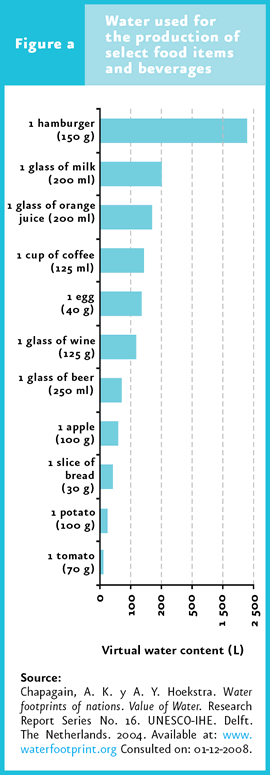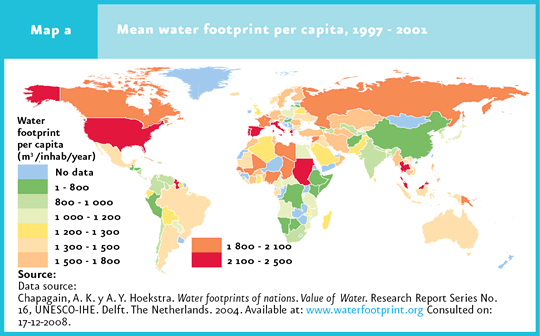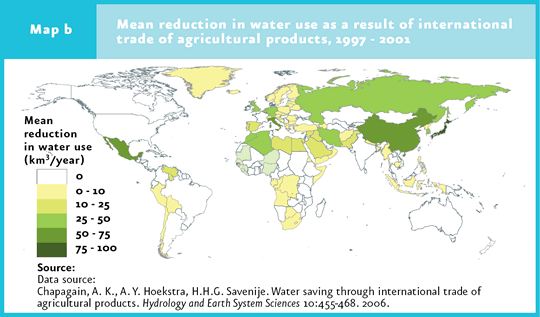Humankind uses large amounts of water for everyday activities, but far more to produce food, paper, clothes and all other consumer products. The hydrological footprint of a country is defined as the total volume of water that is used to produce the goods and services consumed by its inhabitants (Chapagain & Hoekstra, 2004). The hydrological-footprint concept is closely linked to the virtual water concept, which is the amount of water used during the production process of a good or service (Figure a). It should be mentioned that the virtual water content of a product may vary depending on the climate and the conditions under which it was produced.

The hydrological footprint concept was introduced to provide information on the use of water in relation to consumption, and hence supplements the traditional indicators of water use by the different sectors. As an aggregated indicator, it shows the total water requirements of a country, and is a measure of the impact of human consumption on hydrological resources. Worldwide, 86% of the hydrological footprint is related to the consumption of agricultural products, 10% to the consumption of industrial goods and less than 5% to household uses (Chapagain & Hoekstra, 2004).
The individual or per-capita hydrological footprint is the total volume of water used to produce the goods and services consumed by a single individual. It can be estimated by multiplying all the goods and services consumed by each person by their corresponding virtual water content.
The main factors determining the per-capita hydrological footprint of a country are: 1) the average per-capita water consumption, generally related to the gross domestic income; 2) the water consumption habits of its inhabitants (e. g. proportion of meat consumed); 3) climate, particularly the evaporative demand, which determines crops conditions; and 4) farming practices (water use efficiency).
In developed countries, which are characterized by a high consumption of goods and services, the per-capita hydrological footprint is correspondingly high, partly due to the high consumption of meat and industrialized products. Developing countries, where meat consumption is comparatively low, can also have high per-capita hydrological footprints as a result of a low efficiency in the use of water and unfavorable cultivation conditions.
Over the period 1997-2001, the countries with the highest hydrological footprint were India (987 km3), China (883 km3) and the United States (696 km3). Mexico, with a total hydrological footprint of 140 km3/year, ranks tenth worldwide. Because of its per-capita hydrological footprint, estimated at 2 thousand 483 cubic meters per inhabitant per year, the United States ranks first worldwide, whereas China (702 m3/inh/year) and India (980 m3/inh/year) rank in a low position (134th and 108th, respectively). Mexico has an estimated per-capita hydrological footprint of one thousand 441 m3/inh/year (49th worldwide; Map a).

A country’s hydrological footprint can be reduced in several ways, for example: 1) by adopting production systems requiring a lower amount of water per product unit (for instance, water productivity in agriculture can be improved by implementing rainwater collection techniques plus supplementary irrigation); 2) shifting to consumption patterns requiring less water (e. g. reducing the consumption of products the production process of which requires a large amount of water); and 3) relocating production zones to areas with a higher productivity, hence increasing the global efficiency of water use.
The fact that many products consumed in a country can be produced elsewhere means that the actual water demand of a population frequently differs from the figure derived from water extraction volumes. Therefore, a country’s hydrological footprint has both internal and external components. The internal hydrological footprint is the volume used of a country’s own hydrological resources. On the other hand, the external footprint corresponds to the volume of water that is used abroad to produce the goods and services that are imported and consumed by the country’s inhabitants. Mexico ranks sixth worldwide, with a net import of 29 cubic kilometers of virtual water, which reduces its demand for domestic water in 65 cubic kilometers, compared to what would be required if Mexico had to produce the total amount of food to meet the demands of the Mexican population (Map b; Chapagain et al., 2006).

References:
Chapagain, A.K. y A. Y. Hoekstra. Water footprints of nations, Value of Water. Research Report Series. 16, UNESCO-IHE. Delft. The Netherlands. 2004. Disponible en: www.waterfootprint.org Fecha de consulta: 17-12-2008.
Chapagain, A.K., Hoekstra, A.Y., Savenije, H.H.G. Water saving through international trade of agricultural products. Hydrology and Earth System Sciences 10:455–468. 2006. Disponible en: www.waterfootprint.org/ Fecha de consulta: 01-12-08.
|